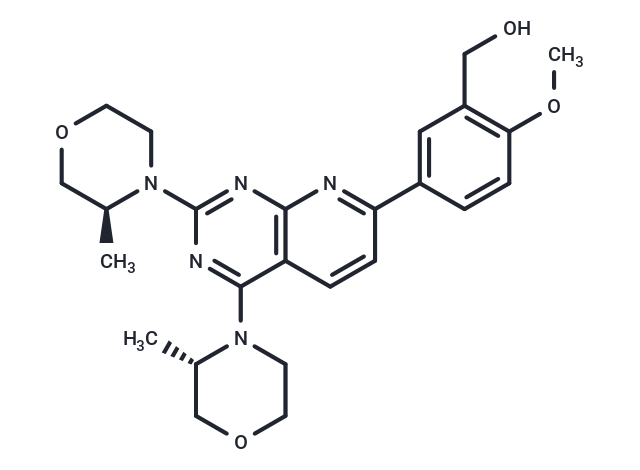Shopping Cart
- Remove All
 Your shopping cart is currently empty
Your shopping cart is currently empty

AZD8055 is an ATP-competitive mTOR inhibitor (IC50: 0.8 nM in MDA-MB-468 cells). It is ~1,000-fold selective for mTOR over all PI3K isoforms.

| Pack Size | Price | Availability | Quantity |
|---|---|---|---|
| 5 mg | $36 | In Stock | |
| 10 mg | $52 | In Stock | |
| 25 mg | $75 | In Stock | |
| 50 mg | $93 | In Stock | |
| 100 mg | $151 | In Stock | |
| 200 mg | $280 | In Stock | |
| 1 mL x 10 mM (in DMSO) | $50 | In Stock |
| Description | AZD8055 is an ATP-competitive mTOR inhibitor (IC50: 0.8 nM in MDA-MB-468 cells). It is ~1,000-fold selective for mTOR over all PI3K isoforms. |
| Targets&IC50 | mTOR:0.8 nM (MDA-MB-468 cells) |
| In vitro | AZD8055 inhibits the phosphorylation of mTORC1 substrates p70S6K and 4E-BP1 as well as phosphorylation of the mTORC2 substrate AKT and downstream proteins. The rapamycin-resistant T37/46 phosphorylation sites on 4E-BP1 were fully inhibited by AZD8055, resulting in significant inhibition of cap-dependent translation. In vitro, AZD8055 potently inhibits proliferation and induces autophagy in H838 and A549 cells [1]. In vitro, the median relative IC50 for AZD8055 against the PPTP cell lines was 24.7?nM. Relative I/O values >0% were observed in 8 cell lines and 15 cell lines showed Relative I/O values ranging from -4.7 to -92.2% [2]. |
| In vivo | In vivo, AZD8055 induces a dose-dependent pharmacodynamic effect on phosphorylated S6 and phosphorylated AKT at plasma concentrations leading to tumor growth inhibition [1]. AZD8055 administration could significantly decrease the IL-1β and TNF-α concentrations. Rats subjected to SAH + vehicle group demonstrated histological evidence of apoptosis compared with the sham group. The group treated with AZD8055 demonstrated a significant decrease in apoptosis ratio in the rat brain sample. In addition, in SAH group, the number of fluoro-jade B-positive cells clearly increased compared with the sham group. And the number of fluoro-jade B-positive cells decreased significantly in the SAH + rapamycin group and SAH + AZD8055 group [3]. |
| Kinase Assay | The activity of mTOR was assayed using the recombinant mTOR technique described above. For inhibition experiments, AZD8055 was added to the reaction mixture and preincubated for 10 min before addition of ATP. Inhibition was performed at 1 to 3,000 nmol/L of AZD8055 in varying concentrations of ATP (40–200 μmol/L) [1]. |
| Cell Research | For growth inhibition and acridine staining, cells were exposed to increasing concentrations of AZD8055 for 72 to 96 h and stained for cell nuclei (0.03 mg/mL Hoechst 33342) and acidic vesicles (1 μg/mL acridine orange). Images were captured at 450 and 536 nm on an ArrayScan II platform, and the percentage of acidic vesicles and the number of cells were quantified. For LC3 assessment, cells were exposed to e64d/pepstatin (10 μg/mL) for 30 to 90 min before incubation with AZD8055. Cells were lysed on ice and analyzed by immunoblotting [1]. |
| Animal Research | Tumor cells (10^6 for U87-MG, 5 × 10^6 for A549) were injected s.c. in a volume of 0.1 mL, and mice were randomized into control and treatment groups when tumor size reached 0.2 cm^3. AZD8055 was formulated in 30% (w/v) captisol (pH 3.0). The control group received the vehicle only. Tumor volumes (measured by caliper), animal body weight, and tumor condition were recorded twice weekly for the duration of the study. The tumor volume was calculated (taking length to be the longest diameter across the tumor and width to be the corresponding perpendicular diameter) using the following formula: (length × width) × √(length × width) × (π/6) [1]. |
| Molecular Weight | 465.54 |
| Formula | C25H31N5O4 |
| Cas No. | 1009298-09-2 |
| Smiles | C[C@@H]1N(C=2C3=C(N=C(N2)N4[C@@H](C)COCC4)N=C(C=C3)C5=CC(CO)=C(OC)C=C5)CCOC1 |
| Relative Density. | 1.248 |
| Storage | Powder: -20°C for 3 years | In solvent: -80°C for 1 year | Shipping with blue ice. |
| Solubility Information | Ethanol: 3 mg/mL (6.44 mM), Sonication is recommended. H2O: < 1 mg/mL (insoluble or slightly soluble) DMSO: 45 mg/mL (96.66 mM), Sonication is recommended. 10% DMSO+40% PEG300+5% Tween 80+45% Saline: 4.5 mg/mL (9.67 mM), In vivo: Please add the solvents sequentially, clarifying the solution as much as possible before adding the next one. Dissolve by heating and/or sonication if necessary. Working solution is recommended to be prepared and used immediately. |
Solution Preparation Table | |

Copyright © 2015-2025 TargetMol Chemicals Inc. All Rights Reserved.